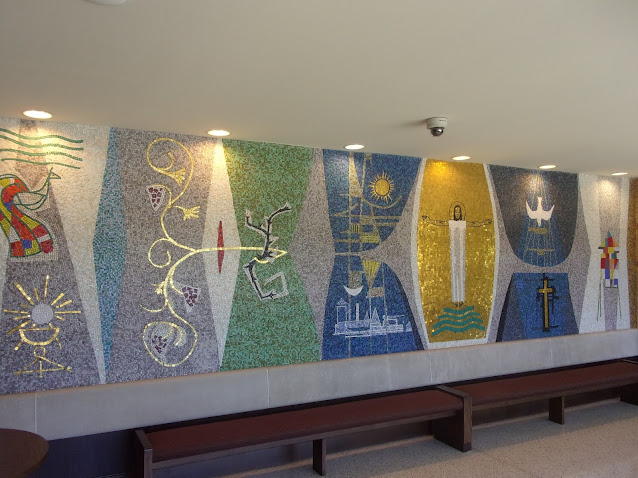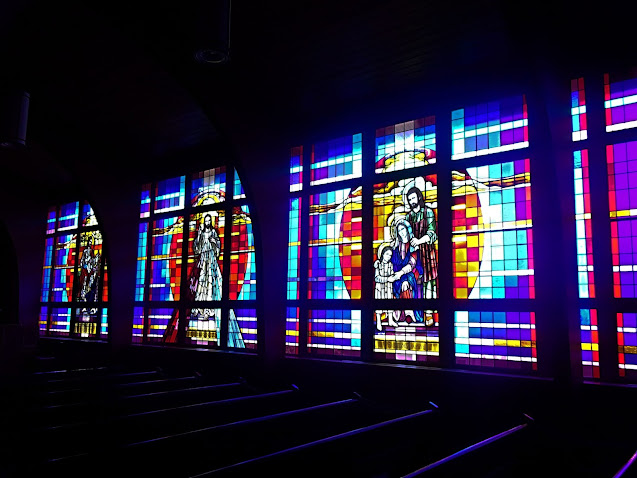
Situated on the southernmost edge of South Bend, Saint Jude is a relatively modern campus for a Catholic parish. Founded in the 1950's, the church was built in the early sixties, and the only major exterior change has been the addition of the spacious and modern rectory.

The original school was constructed as 1st-4th grade and in a few years, kindergarten was added. This fits the neighborhood as it was constructed right in the peacetime fifties of the baby boom era. The school for young children would have been perfect for the neighborhood.

The church is an interesting design. Built in 1960, it was almost directly before the beginning of the Second Vatican council, and already the spirit of Vatican II was making itself known. While the church is not very radical in design, two renovations, one in the seventies, and one in 2012, have left the church was a very modern 21st century look. This includes modern lighting, new stained glass, new pews, and the "bell tower" seen above. The bells however are only models, and don't actually ring.

The statue of Saint Jude has definitely seen better days. It was likely installed at the time of construction for the church and has been oxidizing ever since

This is the rear of the current church. The back cross is typical of the late sixties. Thin, long ends, and above all no corpus, because that would make it seem like we were alienating our protestant brethren.

The vestibule had this very 70's mosaic. One benefit of the wild sixties and seventies was the return of the Mosaic. Largely abandoned in church architecture during the 19th and 20th century, it uses small colored pieces of stone or other materials to create imagery.

The stained glass windows were a pleasant surprise. Originally they were a one shade glass, but it the mid nineties the church added these panes. These match the style of the church as the sixties was a time of transition from scenes depicted in glass to simple polygons in pretty colors. These windows fit this time period nearly perfectly.

The church has been renovated several times since its construction. This has resulted in the original church not being very distinguishable from the constant renovations. Another result is the very modern lighting.

The lighting around the altar is from the most recent renovation. But it's done tastefully enough it's actually enjoyable to look at. The "altar cloths", not so much.

What was confusing was the lights above the altar. Seemingly arranged in a nonsensical pattern, there must be some explanation. (Or maybe there isn't, this is the Novus Ordo!)

Thankfully the tabernacle is still in the center. Once again the modern lighting is done very well. The felt banners hanging however could go. Replace them with images of angels, or maybe have a fresco or a mosaic in their place, it would be a handsome addition.

One classic element of the sixties was the use of floating statues. Rather than have the staues sit on a pedestal, the statues are affixed by the backside to the wall and seemingly float.

The purple is not from any direct lighting nearby, thank goodness, but from the adjacent stained glass. Directly to the right of the statue is the choir area.

A modern confessional. I assume back in the day there would have been a door in the middle where the priest would have sat, hearing confessions on both sides.

Although the stained glass looks era appropriate, there are two signs that it is not original. The first is the purple. In any church I've seen or visited from the sixties, none display purple more prominently than here. The other is the scenes. The holy family, divine mercy, and Jesus and the children do not have any common denominator, give for Jesus himself. Only two are biblical, only two show Jesus ministering to us, and none of them have anything to do with the patron of the parish.

This statue here seems to be very out of place, but likely can be found in every Catholic church built before 1975. (I'd be willing to wager.) This is a depiction of the Infant of Prague. Originally owned by Saint Teresa of Avilla, the statue began to be attributed to miracles after her death. Devotion to this depiction of Jesus was incredibly popular in America amongst immigrant Catholics and subsequent generations. The reason thus statue hasn't been treated to a sixties style makeover, is that this statue is already a makeover. The original statue was of the child Jesus in a simple white garment. Over the years different clergy, devotees, and civic leaders have clad in the statue in different royal robes. Thus this statue is a depiction of a made over statue.




No comments:
Post a Comment